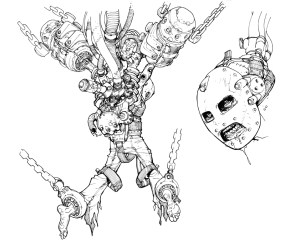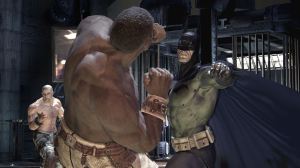Over the decades, the only evil Batman hasn’t been able to vanquish was the dismal awfulness of his own video games. That all changed when Batman: Arkham Asylum–developed by British studio Rocksteady Games–hit consoles and PCs last summer. Gamers finally got to control the hyper-intelligent ass-kicker they’ve been reading about all these years, and not the dull-witted pantywaist cousin who’s apparently been showing up in all those other crap games. Aside from the sales success–nearly two million sold in the first month alone–Arkham’s been winning awards left and right. We corralled members of the development team to find out what makes their action better than the hundreds of other games that came out last year.
For years, the prospect of a decent Batman game seemed about as likely as Bruce Wayne’s parents coming back to life. Where did you guys start when approaching the idea of building Arkham Asylum?
Paul Crocker, lead narrative designer at Rocksteady: From the very beginning, we set out in a very deliberate way to identify the Batman character traits that would translate well into a game. He’s a master of hand-to-hand fighting, he uses stealth and his deductive skills are unmatched. Once we got those, we just kept on concentrating on them. Even at the early days, those things worked. As we went on, they just got better looking and more refined.
So you had it all figured out at the beginning?
PC: Absolutely not! [Laughs] We had those conceptual pillars–which we went on to call Freeflow Combat, Invisible Predator, Detective Mode–defined but they weren’t in the same form as the way they ultimately wound up. Whenever anything didn’t feel like Batman, we tweaked it and changed it.
How exactly did the game’s plot come together?

Paul Dini, writer for DC Comics and Warner Bros. Animation: When I came on board, it was a given that they were going to be doing something with the Arkham setting. The Joker was obviously going to be the main villain but we threw in characters like Bane and Killer Croc to provide a physical threat. I suggested Harley Quinn as being a good foil for Joker and adding Poison Ivy threw another female character into the mix.
The game draws heavily on Batman’s history. Do you think all of these elements and the game overall would work if you stripped away all the Bat-trappings? If the mood, the costume, the lore were all different?
Sefton Hill, game director at Rocksteady Games: That was certainly the goal, but it’s kinda hard to do that because the game was designed to be about Batman from the ground up. We wanted the game to be a real celebration of Batman and everything he stands for. It almost couldn’t be a game about another character. I believe the core mechanics–the Freeflow combat system, the Invisible Predator stealth–could stand on their own but they complement each other because it’s a Batman game. They show the best of who Batman is.
Right now, Dick Grayson is Batman. After being a sidekick as Robin and then becoming Nightwing, he’s worn the cowl since last summer. Would the game have been different if you were basing it on him?
PC: We started before those storylines were happening. Even if they did, we’re about the Batman that anyone on the street would know and that’s Bruce Wayne. With the Dini connection, we really leaned hard on the animated series and that stuff is just great. We would take ideas from those episodes’ character portrayals and skew them into our more realistic world. We got a few that weren’t in the animated series, like obviously [serial killer] Zsasz…
Yeah, he wouldn’t have made it past Standards & Practices.
PC: Exactly.
But, also, you’re not making a movie. What kinds of choices did you guys implement with the focus of keeping things interactive?
PC: Well, the story by its nature had to be linear. We couldn’t do branching story paths but we didn’t then limit your ability to get to certain key points the way you wanted to. But, other stuff like the interview tapes, Spirit of Arkham clues and the Riddler clues were designed to give you a deeper sense of the place, the characters and Batman’s relationship with them. They’re each a smaller story in the world and we wanted people to search them out.
It’s a very mechanically solid game in terms of the way you progress and the way things kind of fit together. But all of that fades away and you’re left with the overall sensation of being enveloped in the experience. To what extent were you guys thinking about the mechanics of fun when building the game? Like, the nuts-and-bolts idea of what makes fun, what doesn’t make fun?
SH: From Rocksteady’s point-of-view, we start out with cool ideas that we think would make for good gameplay. We test, we iterate, we get feedback and we see if people are enjoying it. If they are, we push things as far as they can go. We built two previous combat systems before we settled on one that felt right. You have to be willing to throw things out. These things take time and everything–story elements, gameplay mechanics–was still being tweaked up until the last minute. We were tweaking things until the last minute because it was our only chance to create something good. I think overall one of our big focuses as a developer is an overall focus on the fun of the experience. When you buy a game, it’s supposed to be there to entertain you. But, in a lot of games, you have to play for hours to earn the right to have fun. That’s not really our philosophy on making games. Our philosophy is that you should be enjoying yourself in an immediately immersive experience as soon as you pick up the controller. We try to build a lot of positive reinforcement and enjoyment in the core mechanics. A lot of games have a difficulty curve that’s quite steep until you learn the mechanics of the game and after a while the game kind of starts to give a bit back. We feel that while you’re learning how to play, it should still be fun. It’s kind of a big thing for our Batman game. If you’re walking into a room, we really wanted you to experience what it’d be like to be Batman.
Give an instance of how Arkham Asylum does that “giving-back” thing that you’re talking about.
SH: Right at the start of the game—when you have seven thugs attacking in the first room—we made that really easy. That threat, as Batman, should be quite easy to handle. Taking down seven no-account thugs is no sweat for Batman so we thought, for the player, it should be pretty easy and enjoyable to experience as well. That was a big focus of ours, to make sure that it was a really generous experience and to deliver that kind of wish fulfillment of being Batman. That’s as opposed to having to learn big fancy combos or a crazy combination of moves just to beat up one guy. Innovative ideas should never come at the expense of the fun. Fun has to be the core underlying principal for all the mechanics we come up with. A lot of the time you can come up with something than can be technically kind of interesting but when you actually play it, it’s just not that much fun.
Do you have examples of that from working on Batman?
SH: I guess the combat system is the best example, I can think of. Our combat has a single strike button to begin with,  which is all you need to focus on initially. Then as you play more, you start to use counters and then there are enemies where you need to use the stun. The more you use, the more you realize you can mash up all these different moves. We tried some different systems where everything was much more complicated. Originally, to continue a combo flow, you had to time a button press at exactly the right time [to go from one move into another]. Internally, there were a few people who really liked that because you had to be very skillful to get these big combos. But at the same time, other people were picking up the controller and weren’t getting that experience of being Batman because they were playing and failing to hit enemies successfully.
which is all you need to focus on initially. Then as you play more, you start to use counters and then there are enemies where you need to use the stun. The more you use, the more you realize you can mash up all these different moves. We tried some different systems where everything was much more complicated. Originally, to continue a combo flow, you had to time a button press at exactly the right time [to go from one move into another]. Internally, there were a few people who really liked that because you had to be very skillful to get these big combos. But at the same time, other people were picking up the controller and weren’t getting that experience of being Batman because they were playing and failing to hit enemies successfully.
That seems like a tough balance to strike, in terms of anticipating people’s different skill levels and a game’s inherent difficulty.
SH: Players need to be able to achieve as soon as they pick up the controller. Then, the better you get the more you can overachieve. The better you get at the game, the more the game should give back. If you’ve played the game for five hours and developed these skills, you should not only be able to beat up all these guys but should be able to do it in one combo flow and link all those moves together without missing a beat. That’s the kind of over-achieving that we’ve found players really enjoy because they’re getting something back for all the time they’ve put in.
[Check back tomorrow for Part 2 of this interview.]

